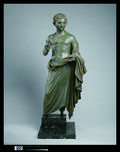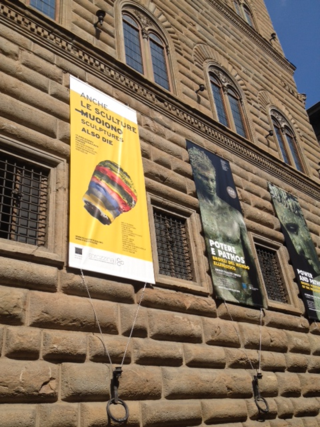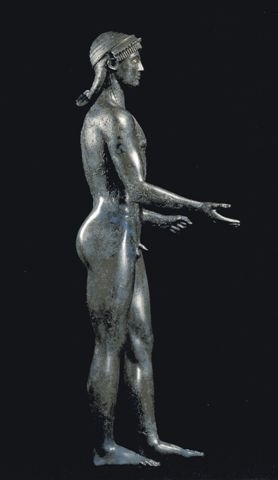Power and Pathos in Florence
This weekend, partly to get a few bits of work done in museums, partly to celebrate almost having the book finished, the husband and I gave ourselves a quick weekend in Florence -- with the aim also of catching the "Power and Pathos" exhibition of Greek and Roman bronze sculpture on at the Strozzi palace. It actually ends in Florence on the 21st, but in case you think this account is therefore just a tease for an exhibition that no reader will be able to see, don't worry: it soon moves to the Getty and then to the National Gallery in Washington DC, where some blog readers will be able to see it.
 The Strozzi show was very good, though to be honest a bit gloomy as you will see from this video. There is a problem in displaying just 50 or so sculptures all in the same medium, but having them against bronze coloured walls in darkened rooms, with spotlights that meant you were always getting your shadow over the pieces didn't honestly alleviate. The husband had taken his own little torch, which really helped to see the details (this might be a tip for future locations too, unless personal lighting devices are forbidden).
The Strozzi show was very good, though to be honest a bit gloomy as you will see from this video. There is a problem in displaying just 50 or so sculptures all in the same medium, but having them against bronze coloured walls in darkened rooms, with spotlights that meant you were always getting your shadow over the pieces didn't honestly alleviate. The husband had taken his own little torch, which really helped to see the details (this might be a tip for future locations too, unless personal lighting devices are forbidden).
There is a very useful catalogue, with a full entry for every piece. I am getting fed up with "catalogues" that give only essays -- though this one has some very useful essays too, on the history of the genre, new discoveries of ancient broze statues(there are lots from underwater archaeology), etc. I thought the object entries by Jens Daehner, Ken Lapatin and Sophie Descamps-Lequime were especially good and clear.
Lapatin's seemed to be notable models of clever understatement. Try this for a quick few lines on a bronze full-sized male statue from Ephesus, restored in Austria at the very end of the 19th century by Wilhelm Sturm, out of 234 separate small pieces: "Although he was guided by a plaster cast of the Uffizi marble statue reproducing the same type, the Viennese sculptor Wilhelm Sturm faced great challenges on account not only of the sheer number of fragments to be reintegrated, but more significantly of the fact that there is no physical contact between the upper and lower body, so that the figure's mid section had to be entirely reconstructed". That is a very judicious way of suggesting that hundreds of tiny fragments were reconstructed on not much basis, by copying a statue in Florence that may of may not have been like it, and entirely reinventing the whole area around its waist, where nothing at all survived. And at the same time Lapation hints at the bigger question of what "conservation" has actually done to most of these bronzes, in giving us impressive works of art lovingly (re)created from some rather battered and torn bits of metal.
But, heavily restored or not (and it would have been nice to have had some more "before" and "after" pictures), there were some great things here, including what is probably a very nice Augustan princeling above. But for me two statues stood out.
One was an exquisite statuette of weary Hercules, just after finishing his last/next to last labour (getting the Golden Apples of the Hesperides), the subject of a famous statue by Lysippos, here beautifully downsized. It's from a sanctuary of Hercules in Italy and has a gorgeous inlaid silver dedication on the base: "Marcus Attius Peticius Marsus fulfilled his vow". Lapatin observes rightly that the apples are missing, presumably they were -- as the husband realised -- originally gorgeous little golden fruits, as likely nicked as "lost".
The other piece, or pair of pieces, that caught my notice were the "archaising" Apollo found in the house of Julius Polybius in Pompeii 1977 (below) -- a bronze figure made in the first century BC or AD, but in the style of a piece 500 years earlier -- and a rather similar statue pulled from the sea off the Italian coast in the nineteenth century.
This pair is well discussed in Dorothy King's blog, which I recommend that anyone interested should visit. But just to add a few questions. There is a common idea that the Romans who bought these "archaising" statues had been conned. "Got a lovely sixth century BC one, sir" says the unscrupulous dealer, when it has actually been turned out down the road by local antique faking workshop. Isn't is just as likely that they were knowingly buying an elegant reproduction for what it was? After all, it seems to have been the Romans who first articulated the period styles of Greek art, so in this kind of production the artists are playing with those ideas of style, not trying to trick.
Second, as King discusses, the statue in the house of Polybius had been made as, or later adapted into, some kind of "lamp stand" or "tray holder", for use in the house's dining room. The fixings for this are on show in the exhibition, but annoyingly there is no photo in the catalogue (though King has managed to get one). As you will see, it is hard to know how exactly the worked. There is a fixing hole right through the statues open hand, but I couldn't see exactly how the attachments were actually fixed.... and, again annoyingly, there is no diagram in the catalogue (perhaps they couldn't work out either).
This is, I guess, where Roman taste doesn't come out so well. The transformation of a rather elegant piece of bronze sculpture (or sculptural type, if you think it was always made like this) into the ancient equivalent of a canap�� holder or standard lamp might at best be called the democratisation of art... but vulgarisation is also a word that comes to mind.
Mary Beard's Blog
- Mary Beard's profile
- 4110 followers






